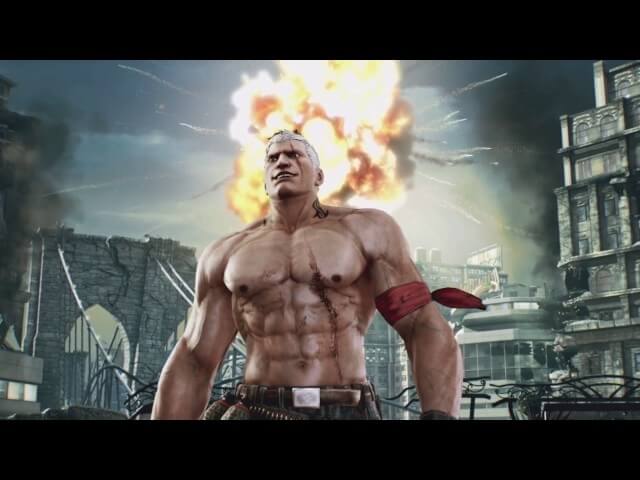
God bless the voice actor who narrates Tekken 7’s story mode. Not because he gives anything resembling what you might call a good performance. No, he deserves credit for the uncanny ability to deliver the game’s hammy, incoherent narrative with enough dispassionate monotone to make it sound mundane. Whether it’s providing sentimental anecdotes about his dead family, killed when a war between corporations rolled through his hometown, or filling us in on the melodramatic absurdity of the supernatural family feud at the center of that global conflict, his awkward cadence and emotionless drawl never changes. By the standards of video game production in 2017, it is mythically bad acting, but as a serious voice for Tekken 7’s maelstrom of stylish lunacy, it’s the perfect symbol of what makes this series so damn charming.
That story mode is the big addition to this home release of Tekken 7, which has been kicking around Japanese arcades since 2015. An hour of ridiculous cut scenes weaving together a handful of fights, and 27 more one-off chapters dedicated to characters who don’t play a role in the main storyline, it’s exactly the kind of over-dramatic nonsense it needs to be, full of gratuitous slow motion, dudes starting a fight by punching each other in the face at the same time (always in slow motion, naturally), lasers being shot from or into space, hilariously specific quick-time events, and overwrought familial drama.
For starters, we’re introduced to the—let’s just call it—contentious father-son relationship between Heihachi and Kazuya Mishima with a washed-out flashback of a prepubescent Kazuya training on the top of a mountain with his father. You control little Kazuya as his futile punches bounce off his father’s legs until the pointy-haired jerk rears back and kicks you across the screen, shouting “Try again in your next life.” Heihachi then carries his unconscious son to a cliff edge and you’re literally prompted to press a button to “Throw Kazuya Off.” And that’s just the first five minutes.
What follows is the tale of a family of cursed assholes, literal and figurative monsters who let their personal vendettas and unchecked power throw the entire world into chaos. It positions Tekken 7 as the hard reboot and refocusing the series needed, giving it the same treatment Mortal Kombat received with its stellar 2011 revival. Memorable scenes from past Tekken games, like Heihachi’s “death” from the opening of Tekken 5, reappear and are integrated into the story’s attempt to turn all this craziness into a single coherent narrative. While it does dial back the weirdness in places—there’s nothing that approaches the zaniest ending cinematics of Tekkens past, all of which are available to be unlocked in Tekken 7’s gallery mode—the game’s earnest embrace of its batshit history and they way it imbues the ridiculous story with legitimate cinematic ambitions, even in the heat of battle, makes it that much more lovable.
Story mode’s dramatic flair bleeds into the rest of the game as well. For the most part, this is still Tekken. Each character has dozens of moves and success usually involves stringing them together to juggle your opponent around the destructible arenas with long, multi-stage combos. (That there isn’t a dedicated tutorial for teaching players how to do that is the game’s biggest flaw.) The most visible changes are the addition of Rage Arts and Rage Drives, powerful moves that fighters can pull off only once their health falls below a certain percentage. Like the Super/Ultra Combos of other fighters, if you connect with a Rage Art, the game transitions into a short scene of you pummeling your opponent, with the camera flying all around to frame the action. More fun are the slow-motion finishes that kick in when both fighters throw out the potential final blows of a close match. It’s heartbreaking to watch a roundhouse pass an inch from your foe’s head as they duck just in time to take you down with a well-placed kick to the shin. Unlike the new Rage moves, which can drastically change the dynamic of a fight, there’s no real utilitarian purpose to these photo finishes. They’re just plain cool to watch.
That puts them in line with just about everything else in Tekken 7. When you get down to it, this is a game with a cast of 35 characters, including two bears, three robots, a vampire, history’s buffest grandpa, a dude from another game series who’s now been inexplicably written into Tekken lore, a lady who throws tigers, and whatever the hell Yoshimitsu is. It’s a flashy, delirious mess whose love for all that messiness is tangibly honest and infectious. I haven’t even minded that its earliest days were mired with connectivity problems that kept me from getting online to fight. I was plenty happy to just hop into Treasure Mode, take on its endless gauntlet of ridiculously costumed computer-controlled characters, and unlock wacky hats, accessories, and wrestling T-shirts to force on my favorite characters. So if you’re fighting online and see a leopard-headed luchador dressed like a 1950s insurance salesman who also happens to wear a pair of novelty hypnotic glasses, it might just be me, and know that I couldn’t be happier about how dumb this all is.
Tekken 7
Developer: Bandai Namco Studios
Publisher: Bandai Namco
Platform: PC, PlayStation 4, Xbox One
Rating: T
Price: $60 on consoles; $50 on PC
Purchase Tekken 7 here, which helps support The A.V. Club.